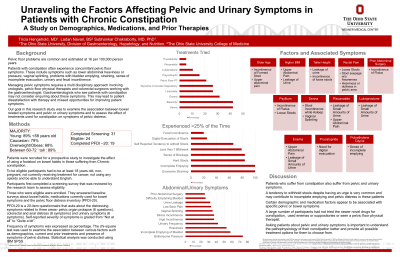Monday Poster Session
Category: Functional Bowel Disease
P1953 - Unraveling the Factors Affecting Pelvic and Urinary Symptoms in Patients With Chronic Constipation: A Study on Demographics, Medications, and Prior Therapies
Monday, October 23, 2023
10:30 AM - 4:15 PM PT
Location: Exhibit Hall

Has Audio

Tricia A. Hengehold, MD
The Ohio State University
Columbus, OH
Presenting Author(s)
Tricia A. Hengehold, MD1, Ladan Navari, BS2, Subhankar Chakraborty, MD, PhD1
1The Ohio State University, Columbus, OH; 2The Ohio State University College of Medicine, Columbus, OH
Introduction: Problems with bowel movements can be associated with pelvic floor symptoms. We sought to assess the association between bowel symptoms and pelvic or urinary symptoms, and the effect of treatments used for constipation on symptoms of pelvic distress.
Methods: Non-pregnant adults without active cancer or opioid use were prospectively recruited for this study. The pelvic floor distress inventory (PFDI-20) was used to assess pelvic symptoms.
Results: 31 people signed up, 24 were eligible (21 female) and 19 completed the questionnaires. Majority (79%) were white, younger than 58 years (89.4%), between 60-72 inches tall (89.5%) and overweight or obese (68.4%). Most (79%) had less than 7 bowel movements per week, and reported hard stools (84%), excessive straining (100%), incomplete emptying (100%) and sense of rectal blockage (84%) more than 25% of the time. About 1 in 4 reported digital evacuation of stools. About 1 in 5 reported fecal incontinence. About 1 in 3 reported low back pain, 1 in 4 had prior abdominal surgery and 2 of 3 reported tendency to withhold stools despite getting an urge. Bothersome pressure (74%) or heaviness (53%) in the lower abdomen, vaginal splinting (35%), sense of incomplete emptying of the bladder (58%) were common. Bothersome urinary frequency (42%), urge incontinence (37%), stress incontinence (37%), small amount of urine leakage (32%) and difficulty emptying the bladder (26%) were reported. Soluble fiber supplements, specifically psyllium, polyethylene glycol, senna and bisacodyl, were most tried medications for constipation either currently or in the past. About 1 in 5 people had tried pelvic floor PT before. Certain medications, demographic factors and prior therapies were associated with pelvic floor symptoms (Table 1). Rectal pain was associated with seepage of stool without awareness and heaviness in the pelvic area.
Discussion: Bothersome pelvic and urinary symptoms are common in people suffering from symptoms of bowel evacuation disorder. Most reported a withholding behavior which could contribute to bowel and pelvic symptoms. Demographic factors, medications used to treat constipation and prior therapies appear to be associated with certain patient reported symptoms. Our findings highlight the complexity of treating those with constipation and the need to consider these factors when discussing management.
Disclosures:
Tricia A. Hengehold, MD1, Ladan Navari, BS2, Subhankar Chakraborty, MD, PhD1. P1953 - Unraveling the Factors Affecting Pelvic and Urinary Symptoms in Patients With Chronic Constipation: A Study on Demographics, Medications, and Prior Therapies, ACG 2023 Annual Scientific Meeting Abstracts. Vancouver, BC, Canada: American College of Gastroenterology.
1The Ohio State University, Columbus, OH; 2The Ohio State University College of Medicine, Columbus, OH
Introduction: Problems with bowel movements can be associated with pelvic floor symptoms. We sought to assess the association between bowel symptoms and pelvic or urinary symptoms, and the effect of treatments used for constipation on symptoms of pelvic distress.
Methods: Non-pregnant adults without active cancer or opioid use were prospectively recruited for this study. The pelvic floor distress inventory (PFDI-20) was used to assess pelvic symptoms.
Results: 31 people signed up, 24 were eligible (21 female) and 19 completed the questionnaires. Majority (79%) were white, younger than 58 years (89.4%), between 60-72 inches tall (89.5%) and overweight or obese (68.4%). Most (79%) had less than 7 bowel movements per week, and reported hard stools (84%), excessive straining (100%), incomplete emptying (100%) and sense of rectal blockage (84%) more than 25% of the time. About 1 in 4 reported digital evacuation of stools. About 1 in 5 reported fecal incontinence. About 1 in 3 reported low back pain, 1 in 4 had prior abdominal surgery and 2 of 3 reported tendency to withhold stools despite getting an urge. Bothersome pressure (74%) or heaviness (53%) in the lower abdomen, vaginal splinting (35%), sense of incomplete emptying of the bladder (58%) were common. Bothersome urinary frequency (42%), urge incontinence (37%), stress incontinence (37%), small amount of urine leakage (32%) and difficulty emptying the bladder (26%) were reported. Soluble fiber supplements, specifically psyllium, polyethylene glycol, senna and bisacodyl, were most tried medications for constipation either currently or in the past. About 1 in 5 people had tried pelvic floor PT before. Certain medications, demographic factors and prior therapies were associated with pelvic floor symptoms (Table 1). Rectal pain was associated with seepage of stool without awareness and heaviness in the pelvic area.
Discussion: Bothersome pelvic and urinary symptoms are common in people suffering from symptoms of bowel evacuation disorder. Most reported a withholding behavior which could contribute to bowel and pelvic symptoms. Demographic factors, medications used to treat constipation and prior therapies appear to be associated with certain patient reported symptoms. Our findings highlight the complexity of treating those with constipation and the need to consider these factors when discussing management.
Disclosures:
Tricia Hengehold indicated no relevant financial relationships.
Ladan Navari indicated no relevant financial relationships.
Subhankar Chakraborty: Coloplast – Consultant. Medtronic – Consultant.
Tricia A. Hengehold, MD1, Ladan Navari, BS2, Subhankar Chakraborty, MD, PhD1. P1953 - Unraveling the Factors Affecting Pelvic and Urinary Symptoms in Patients With Chronic Constipation: A Study on Demographics, Medications, and Prior Therapies, ACG 2023 Annual Scientific Meeting Abstracts. Vancouver, BC, Canada: American College of Gastroenterology.
